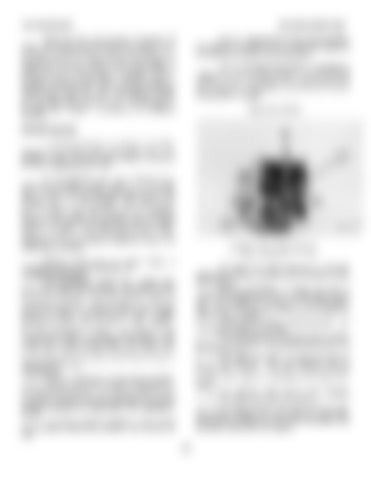3161 GOVERNOR
SYSTEMS OPERATION
When the pilot valve plunger is lowered, oil under high pressure moves through the control port of the bushing, to the bottom side of the power piston, and the piston moves up. When the pilot valve plunger is raised, the oil from the bottom of the power piston is released to sump, and the higher oil pressure on top of the piston moves the piston down. When the engine is running at a steady state, the control land of the pilot valve plunger covers the ports in the ballhead bushing and the power piston does not move. The movement of the pilot valve plunger is controlled by the ballhead assembly.
The 3161 Standard and Torque Rise Governors are designed to operate with a 2 to 8 percent droop and have an internal droop pivot pin adjustment. The 3161 Generator Set Governor is designed to operate with a 0 to 4 percent droop. It has an external adjustment lever connected to the internal droop pivot pin. This permits droop adjustments to be on the outside of the governor housing.
Torque Rise Control
Ballhead Assembly The ballhead system has a ballhead, flyweights, speeder spring, thrust bearing, and speeder plug. The ballhead, as part of the pilot valve bushing, is turned by the drive coupling and drive shaft. As the ballhead turns, the centrifugal force causes the flyweights to pivot outward. At the same time, the force of the speeder spring pushes the thrust bearing down on the flyweight toes against the centrifugal force of the flyweights. When the speeder plug is pushed down this increases the downward pressure on the speeder spring, and the governor speed setting is increased. The engine then runs at a higher speed and puts a higher centrifugal force on the flyweights to equal the speeder spring force and put the system back in balance.
TORQUE RISE COMPONENTS 1. Torque control lever. 2. Cam.
Speeder spring force or speed setting is controlled through the speed setting shaft. Compensation System The compensation system has a needle valve and a buffer piston with two springs. This system can be adjusted to give the desired rate of governor control and engine speed stability. Since the governor makes an adjustment rapidly to a change in engine load or speed setting, the engine can go into a "hunt" condition (temporary increase and decrease in engine speed) if too much adjustment is made. The purpose of the compensation system is to prevent overcorrection to the engine load or speed setting change. The system uses a pressure differential that is applied across the compensation land of the pilot valve plunger to give a stable governor control. Speed Droop The 3161 Governor is an isochronous governor with the ability to operate with droop by the adjustment of an internal droop pivot pin. The governor may be used with droop to allow for load division between two or more engines connected to a single shaft, or for operating in parallel. The speed droop of a governor is the percent that the engine speed drops between high idle and full load.
The torque rise control consists of a cam that makes the governor give more fuel to the engine under lug conditions. Different percentages of torque rise can be selected by changing the cam to a programmed rate of rise. This change can be made on or off the engine. Cam selection and high idle settings must be based on factory recommendations. The torque rise control is factory installed. It is not practical to install it in the field. The torque rise cam has three distinct profiles: the base circle area (3); the approach ramp area (4); and the cam lift area (5). The "base circle area" is a radius that does not lift the cam follower. The cam follower must be positioned on the base circle area when the dial indicator is zeroed, for a check or adjustment of the torque rise setting. The "approach ramp area" is the "transition area" from the base circle to the cam lift area. The "cam lift area" is the area on the cam that lifts the cam follower and torque rise pilot valve lever, which allows additional fuel for torque rise greater than the natural torque rise of the engine.
160

























































































